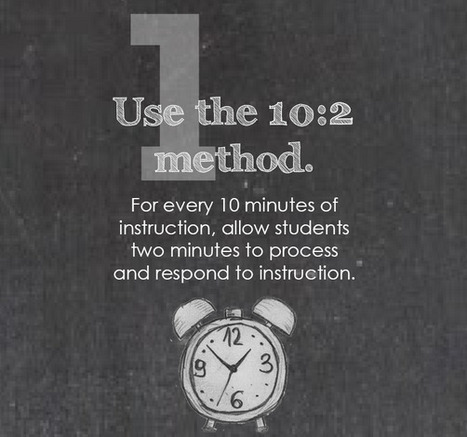 Your new post is loading...
 Your new post is loading...
Too often, it is felt that personalised feedback can only be provided in subjects with small learner enrolments. However, this case demonstrates that personalised, high-quality feedback can be provided consistently and at scale in a large first-year subject.
In this core Health subject, undertaken by learners from a broad range of disciplines, learners complete a series of three journal entries as their major assessment piece. Learners receive audio feedback from the same educator across their three journal entries, fostering a sense of personal connection between learner and educator. Educators also receive audio feedback through the feedback moderation process, which both ensures consistency amongst the large team of educators and supports the development of educators’ own feedback practices.
Via Peter Mellow
En el artículo anterior comenzamos a ver los diferentes tipos de crítica y su grado de utilidad; en concreto vimos la crítica destructiva y su inutilidad para el aprendizaje, la mejora de resultados o el desarrollo profesional; además de desmotivar, su aportación a nivel técnico es nula.
Via MyKLogica

|
Scooped by
juandoming
|
There is only one way to avoid criticism: do nothing, say nothing, and be nothing.”
Aristotle’s words may be a wake-up call for those who prefer a quiet life, but thankfully in today’s business world performance reviews have generally moved away from negative criticism and towards constructive feedback.
But it has to be said that there is feedback, and then there is feedback; and whilst one is the sort of tick box exercise that leaves you feeling none the wiser, the other can be a genuinely helpful pointer towards personal development.

|
Scooped by
juandoming
|
As part of my job on the New School MA TESOL program, I've been collating evaluations of the last semester's online courses. What really stands out are the extremely positive ratings of the teaching faculty: not surprising perhaps, given their collective expertise, but when you consider that the students never actually see their instructors, such…
A maioria concorda que a crítica construtiva é bom: ele nos ajuda a crescer. Muitos também concordariam que a crítica construtiva é uma parte integrante do processo educativo online. Simplificando, se você é um estudante que não está a receber críticas construtivas a respeito de seus escrita, habilidades, pensamentos e idéias, então você não está recebendo um bom retorno sobre seu investimento educacional. Se você é uma faculdade e você não está fornecendo este tipo de feedback, você não está cumprindo suas responsabilidades como um educador. Então, por que é crítica construtiva tão difícil de dar e ainda mais difícil de tomar? Se você está apontando fraqueza de alguém, ou aquele cujo fraquezas estão sendo expostos, críticas (construtivas ou não) pode facilmente levar a um estado desconfortável. Esta é a natureza humana. Em um ambiente on-line, sem sinais não-verbais, torna-se ainda mais difícil. Por exemplo, em um ambiente tradicional um instrutor explica a um estudante em uma voz calma e encorajadora (enquanto faz contato visual) como revisar um documento para satisfazer os resultados de aprendizagem do curso. No ambiente online, o feedback é despojado de tom e linguagem corporal eo aluno vê um papel (que o tempo da família custo ou trabalho de escrever) banhado em vermelho, o registo de alterações que marcam a maioria dos parágrafos, e comentários em cascata até a margem. Em um ambiente on-line , é importante perceber que o feedback e classificação são parte do processo de educação. Uma das principais funções do corpo docente é fornecer feedback sobre o trabalho do aluno. Isto envolve não só oferecendo orientações e instruções aos recursos, mas também sugestões sobre como melhorar. O feedback também ajuda os alunos a aperfeiçoar competências e conhecimentos. Qualquer pessoa que trabalhe ou de aprendizagem on-line deve aprender a amar o feedback; e pedir mais!
Via Miloš Bajčetić, Carlos Rodrigues Cadre
Volunteer name: Agathe Kuhn
Project location: La Serena- Chile
Program dates: Feb 8th - April 5th 2015
Volunteered at: Orphanage and School
...
Via ABroaderView
"Here are 12 good tools for gathering real time feedback from students ..." ©
Via Leona Ungerer
El feedback y las notas de retroalimentación son un sujeto constante de interpretaciones inexactas y malos entendidos; si piensas en implementar esta sencilla y gratuita innovación, pero compleja a la vez, y crucial, en tus evaluaciones, es bueno que tengas en cuenta los siguientes puntos.
Via Gumersindo Fernández
"The difference between assessment of learning and assessment for learning is a crucial one, in many ways indicative of an important shift in education. Traditionally, tests have told teachers and parents how a student “does,” then offers a very accessible point of data (usually percentage correct and subsequent letter grade) that is reported to parents as a performance indicator."
Via Beth Dichter

|
Scooped by
juandoming
|
|
When we provide feedback in branching scenarios, we have several questions to consider. Should we provide consequences (intrinsic feedback) or coaching (instructional feedback)? Should we provide immediate feedback or delayed feedback? What works for novices versus experts? Intrinsic and Instructional Feedback In Scenario-based e-Learning: Evidence-Based Guidelines for Online Workforce Learning, Ruth Clark recommends combining intrinsic…
Via Marta Torán
Hoy os traigo unas herramientas digitales que dinamizan la evaluación convencional. Los docentes podemos corregir los trabajos del alumnado y dar feedback de forma inmediata con algunas de las herramientas que presento a continuación.
Es importante remarcar que el feedback (individualizado en lo posible) acerca al alumno/a al conocimiento y a la mejora de su propio aprendizaje (Bellon, 1991).
Via Gumersindo Fernández
Los profesores nos quejamos mucho de la dificultad de atender a grupos heterogéneos de alumnos por el enorme esfuerzo que supone ajustarse a varios niveles en las explicaciones y en las actividades. Curiosamente, solemos ignorar uno de los mejores recursos para conseguirlo, que es el “feedback” que damos a los alumnos sobre su trabajo. Aquí es cuando presento la Guía avanzada sobre cómo dar “feedback” a los alumnos, editada (en inglés) por la Asociación Australiana de Enseñanza Basada en Evidencias
Via Gumersindo Fernández
"A year ago, Google marked Teacher Appreciation Week in the US by announcing the arrival of Google Classroom ..." ©
Via Leona Ungerer
The level of student engagement can vary from student to student, and lesson to lesson so it may be difficult to get a general feel for how engaged a class is as a whole. To that end, Schlechty (2002) also outlined three categories that can be used to measure the level of engagement for an entire classroom. The Engaged Classroom The Compliant Classroom The Off-Task Classroom
Via Beth Dichter, Mark E. Deschaine, PhD, CECI Jean-François, Marcel Lebrun
In Google Documents you have the ability to add comments. These comments look a little like sticky notes on the side of the document and they line up with the spot in the document that the comment ...
Via Tom D'Amico (@TDOttawa)
Jisc webinar on outcomes from the Assessment and Feedback programme 4 Dec 2013
Via Elizabeth E Charles

|
Scooped by
juandoming
|
This is the final post in a 3 part series on group work in online learning communities. Post 1 featured why we need group work in online learning... (via @juandoming)
|



 Your new post is loading...
Your new post is loading...








































